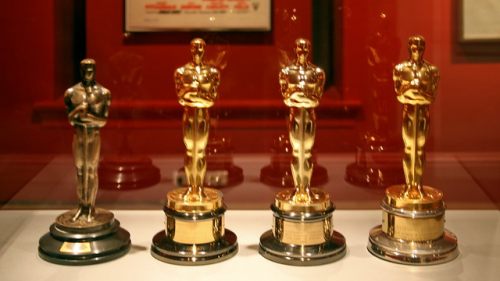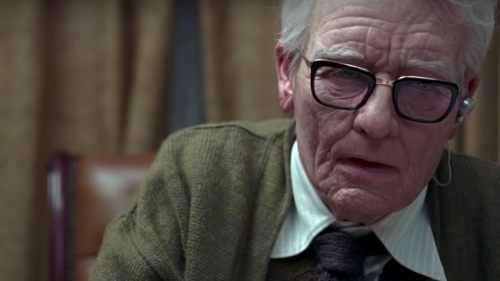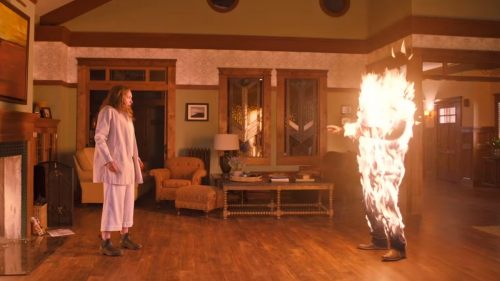Who Gives A Shit If The Oscars Don’t Respect Horror?
It's that time of year again, folks. Oscar nominations are out and horror fans are Mad Online about it. There are many deserving names on the ballot, and a few debatable ones, just like every year. And just like every year, horror fans get the satisfaction of maybe one of their beloved movies getting Daddy's approval (this year sees Jarin Blaschke score a Cinematography nomination for Robert Eggers' beautiful, briny, orthochromatic gem The Lighthouse). And just like every year, the snubs were as fruitful as a pagan wreath. Lupita Nyong'o's bonkers double-performance in doppelganger joint Us went unacknowledged from the Academy, as did Jordan Peele's stunning sophomore directorial effort entirely. But hey, Midsommar powerhouse Florence Pugh got a Best Actress nod - for Little Women. The social media wails were immediate, flooding the feeds as they do every time we go on this merry-go-round.
Here's the thing: it's fine that horror goes unacknowledged by The Academy.
Horror is a genre that exists on the fringes of cinema. It's young - the term "horror" in relation to cinema only gained traction with Dracula's release in 1931. The target of protests, bans, and even video store raids, it's that cousin that just won't act right. Horror contains ahistorical, consistent components that both hinder mainstream recognition and enable profound narratives.
In his cinephile Bible Danse Macabre, Stephen King breaks horror fiction down as a two-pronged fork of confrontation: terror and the repulsive. Terror germinates from an unforgiving barrage of disestablishment, the sudden awareness that "things are in the unmaking." The old chestnut example is the Kennedy assassination, but you might have felt the same pang of general unease if you were of age during a terrorist attack, or if you were a kid in North America when the Columbine massacre went down. It's the sense that the facade of the world as you knew it is slipping, and nothing will ever be the same again. Its sinister sister is the Uncanny, a conflict between reality as we know it and the reality in front of us. From Tod Browning's Freaks to 2019's Us, fright is often marked by the Uncanny, which can often be wrapped up in grotesquery. The genre lives in this pocket, and it takes skill and finesse to take an audience on that journey and keep them there for an extended period of time.
Then there's what King calls "the gag reflex of revulsion": the severed, ant-ridden head of a young girl on the side of a road; a phallic, fanged creature bursting out of a grown man's chest; a pie made with, uh, menstrual materials. The gross-out is certainly as effective as terror, but it's easily misapplied and overused. To be fair, a ton of horror movies are guilty of this, seemingly for no reason other than to shock. Other times, the shock is the point, a spike in the railroad to drive home a greater thematic message about ultraviolence and the complicity of the spectator (looking at you, Funny Games). The common thread in our most acclaimed annual genre picks is that they utilize gore and violence with purpose, and to great effect. I can't name any but the most foul kills in any given slasher franchise entry, but you can bet dollars to donuts that I remember every sledgehammer to the face, every boiling bear, and every skinned Fool of Midsommar. The same goes for Daniel Isn't Real, The Golden Glove, The Color Out of Space, and Us. There's a reason why horror was kneecapped during the Hays Code era, and why horror made up a staggeringly disproportionate percentage of films subject to British prosecution during the 1980s. The gross-out and the spectacle confronts and provokes, and that always has and always will go against the grain.
I said all of that to say this: in understanding the attitudes surrounding the genre, it's important to also grasp that these yarn-spinning techniques are both blessing and curse. All of these elicited emotions - the terror, fright, outrage, and suspicion - are straight caveman shit; the primeval motivators for the human race since Grog stood upright and mastered the flame. That's the problem: many look at stories that prioritize horror, terror, and revulsion as their main storytelling tools as they would look at sideshow performers. Sure, they do amazing things and marvel audiences, but is it art performance? Of course it is, don't be a moron. But only one will be considered art by the powers that be. A circus illusionist won't get the acclaim that a star of the Bolshoi Theater will, but for a spell (and for the price of admission), they'll captivate you and make you reconsider the reality and world that you live in.
That's the rub, isn't it? The realities that horror confronts you with aren't easy pills to swallow. We can credit that to the medicine itself, the presentation, and sometimes both. Some films force-feed their sentiments and accost with disgusting visuals, as the New French Extremity films did. Others, like Karyn Kusama's colossally undersung chiller The Invitation, use an IV drip to slow-push that dread throughout your body. Either way, it's considered base and lowbrow to confront audiences with such negative, primitive emotions for one to two hours on-screen.
But the fact that the genre is overlooked and sneered at is also a good thing. That outsider status is exactly what gives horror filmmakers the leeway to confront and provoke with the Big Duo (terror and revulsion) to deliver the sobering messages that lie underneath the monstrous surface. American playwright Bill Gunn could have jumped on the surge of black representation in film during the '70s and wrote a nice little tidy domestic tale about addiction and black assimilation into a domineering, toxic white culture. He would've likely had to avoid going too hard with the themes lest he anger career-ending nice white people, and he probably would've won more awards for doing so. But what he did was throw vampires into the story and in 1973 we got the highly important and groundbreaking Ganja and Hess. Ridley Scott could have served up a ho-hum contemporary naval drama (of which there were already plenty in the decades leading up to 1979) and speak on class division and the perils of scientific advancement, sure. Or he could put everything in space and have these same elements locked in a vessel with an invasive, man-raping extra-terrestrial, and we get Alien. When done right, going lowbrow can make those hard-to-swallow thematic pills easier to digest. Put a nice-enough socially lofty couple in a room and watch the power dynamics slowly, then explosively destroy them, and boom - Oscar gold.* But the story itself has been done the same way, so many times. The melodrama can feel forced, or the worse: safe.
But take a nice-enough couple and watch their bond unravel within a rural Nordic cult commune? Now we're cooking with peanut oil. Why does it work so well? Because the melodrama is a feature of the system, not a bug. The histrionics are built-in, as is the violence, as part of the exhausting but cathartic dance that the spectator takes part in. Both of the aforementioned films have bittersweet "happy" endings, but only one has taken the viewer through an emotional ringer that includes the Big Duo, thus lancing the boil and allowing the spectator catharsis to match the narrative resolution. Horror is an emotional and spiritual bloodletting, and the blood makes it routinely less than art in the eyes of the cinema crowd. Directors might prove themselves with it, but they'll rarely get a gold star from the teacher until they move onto more "appropriate" fare, like white people getting a divorce. Horror is rebellion. It resists entrenched norms, social confines, and dearly-held values. And as any punk-goth-metalhead knows, you can't reject the normies and still ask to sit at their table.
But we're vain creatures, and we crave recognition for ourselves and our faves. Fortunately, horror and alt-film giants have made and continue to make their own community analogs to the golden statue. Joe Bob Briggs came in early with the Hubbies for drive-in fare, BMD has their own Alternate Oscars, and Fangoria has the Chainsaw Awards specifically for horror and thrillers, with such categories as "Best Limited Release" and "Best Kill." Keep an eye on your favorite genre film publication, and you just might get the US nod you've been crying over on Twitter for the past week.
Like any genre, horror stories change with the times, only retaining the skeletal components that identify it as horror. The difference is that horror operates largely outside the norm. To thoroughly bastardize a Pauline Kael quote, horror directors uncovered the poetry of rage and fear, and showed the rest how to put it on screen in a new, existential way. This generally isn't appreciated, and you'll be hard-pressed to see any appreciation from an awards show that largely exists to confirm its own image. So horror may not be invited to the midnight ball, and there's a fair sting in seeing other beaus and belles waltz around under the bright lights. But we have our own soiree: the danse macabre. To quote the best line of 2016 horror-thriller-banger Green Room, "Who gives a shit?"
*For the record, I enjoyed Marriage Story. Calm down.



